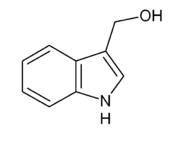Indole-3-carbinol
 |
|
| Names | |
|---|---|
|
IUPAC name
1H-Indol-3-ylmethanol
|
|
| Other names
Indole-3-carbinol; 3-Indolylcarbinol; 1H-Indole-3-methanol; 3-Hydroxymethylindole; 3-Indolemethanol; Indole-3-methanol; I3C
|
|
| Identifiers | |
|
3D model (Jmol)
|
|
| ChEBI | |
| ChemSpider | |
| ECHA InfoCard | 100.010.762 |
| EC Number | 211-836-2 |
|
PubChem CID
|
|
| RTECS number | NL9483000 |
|
|
|
|
| Properties | |
| C9H9NO | |
| Molar mass | 147.18 g·mol−1 |
| Appearance | Off-white solid |
| Melting point | 96 to 99 °C (205 to 210 °F; 369 to 372 K) |
| Partially in cold water | |
| Hazards | |
|
EU classification (DSD)
|
Irritating (Xi) |
| R-phrases | R36/38 |
| S-phrases | S26, S36 |
| NFPA 704 | |
|
Except where otherwise noted, data are given for materials in their standard state (at 25 °C [77 °F], 100 kPa).
|
|
|
|
|
| Infobox references | |
Indole-3-carbinol (C9H9NO) is produced by the breakdown of the glucosinolate glucobrassicin, which can be found at relatively high levels in cruciferous vegetables such as broccoli, cabbage, cauliflower, brussels sprouts, collard greens and kale. It is also available in dietary supplements. Indole-3-carbinol is the subject of on-going biomedical research into its possible anticarcinogenic,antioxidant, and anti-atherogenic effects. Research on indole-3-carbinol has been conducted primarily using laboratory animals and cultured cells. Limited and inconclusive human studies have been reported. A recent review of the biomedical research literature found that "evidence of an inverse association between cruciferous vegetable intake and breast or prostate cancer in humans is limited and inconsistent" and "larger randomized controlled trials are needed" to determine if supplemental indole-3-carbinol has health benefits.
Investigation of mechanisms by which consumption of indole-3-carbinol might influence cancer incidence focuses on its ability to alter estrogen metabolism and other cellular effects. Controlled studies have been performed on such animals as rats, mice, and rainbow trout, introducing various controlled levels of carcinogens, and levels of Indole-3-carbinol into their daily diet. Results showed dose-related decreases in tumor susceptibility due to Indole-3-carbinol (inferred by decreases in aflatoxin-DNA binding). The first direct evidence of pure anti-initiating activity by a natural anticarcinogen (indole-3-carbinol) found in human diet was claimed by Dashwood, et al., in 1989.
...
Wikipedia

